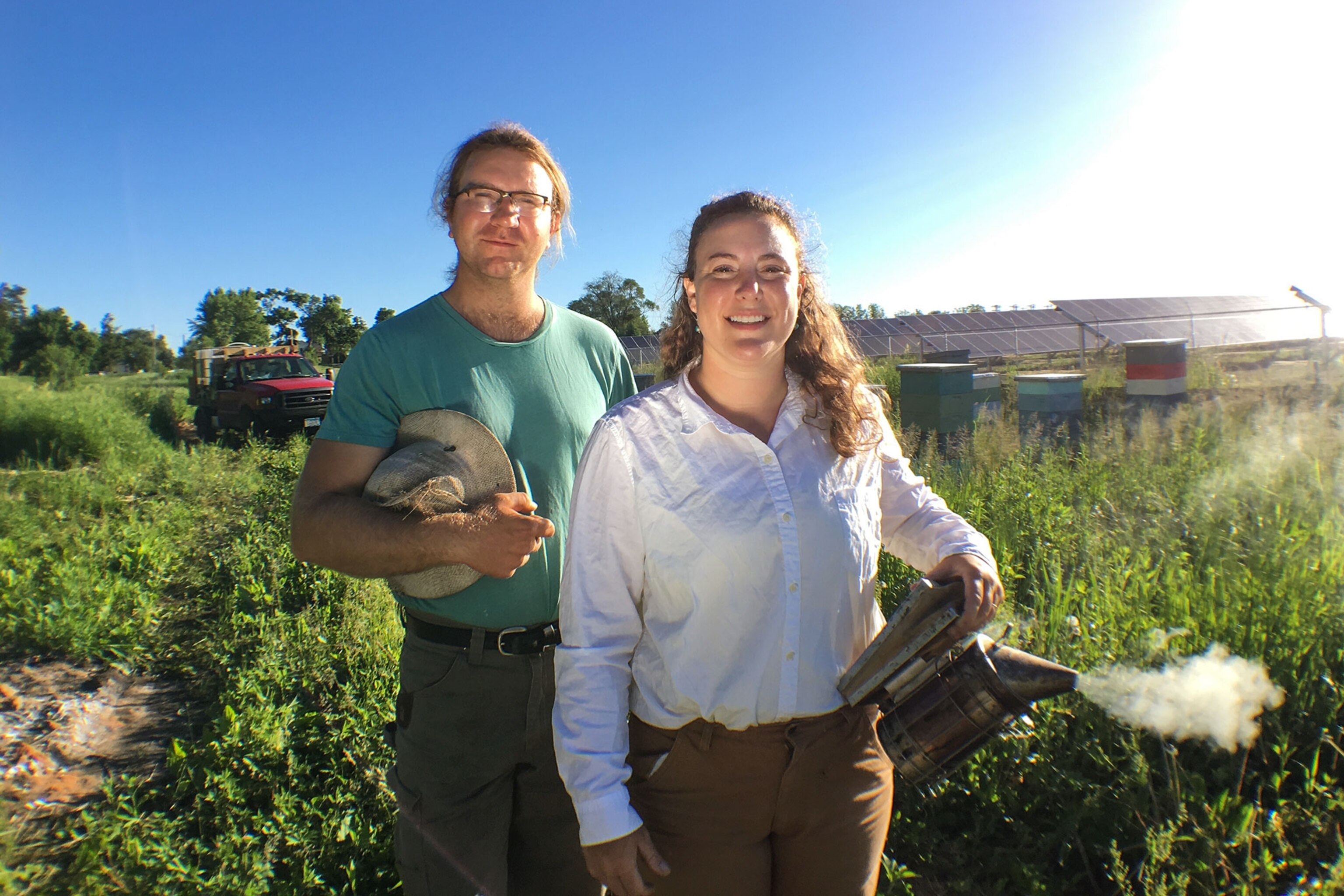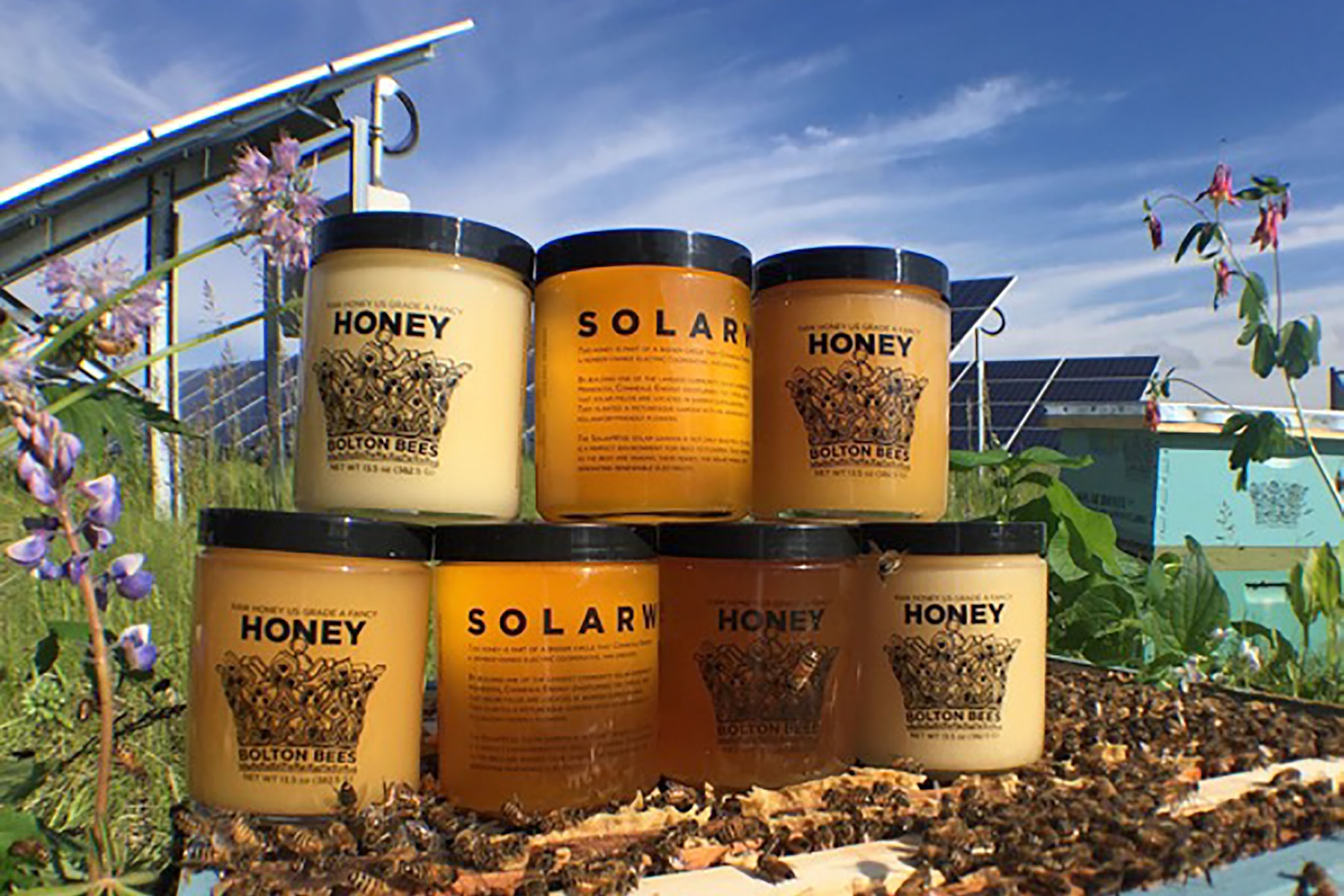
Beekeepers Sweeten Solar Sites With the 'Tesla of Honey'
By pairing pollinators with solar farms, Travis and Chiara Bolton are reimagining commercial beekeeping.
The SolarWise garden in Ramsey, Minnesota, doesn't look especially cutting edge as solar farms go. But in April, it quietly achieved a milestone: It became the first U.S. solar facility to host commercial beekeeping. The apiary is part of an effort to rethink how land for clean energy can be used to supply more than just kilowatts.
Instead of the gravel or turf grass that typically underlies a solar array, the one in Ramsey has low-growing, pollinator-friendly plants and 15 hives installed by Bolton Bees, a local honey producer about 35 miles away in St. Paul. Two other solar apiaries followed in the state, with more on the way.
The rise of solar energy in the United States coincides with a growing awareness that pollinators, which help grow three-quarters of the world's food crops, are in trouble. American produce ranging from almonds to blueberries depends heavily on this winged workforce. But in the U.S., beekeepers lost more than 40 percent of their colonies in 2016 due to a variety of factors.

The couple behind Bolton Bees, Travis and Chiara Bolton, are building their small business on an expansive vision, one where the use of land for solar is sweetened by the presence of local bees. (See nine ways you can help bees at home.)
Chiara Bolton first learned about beekeeping on an economic development project in rural Tibet. But when she tried it back home, she learned how hard it was to keep bees alive during the harsh Minnesota winters.
"I kind of got hooked," she says. Together, season after season, she and Travis bred Minnesota-hardy bees and found a market among backyard beekeepers who needed queens that could withstand the winters.
At the time, she was a nursing home manager and he had a home remodeling business. But two years ago, they quit their existing jobs to focus full-time on beekeeping, selling both bees and location-specific honey.
"One of the things that’s so special about beekeeping is you get to be in nature all day, every day," Travis Bolton says. "Our office is in a beautiful meadow surrounded by woods."
When they saw a solar array go up nearby, they mused that it might make a good location for hives. But they didn't pursue the idea until a local clean energy advocate, Fresh Energy, invited them to install hives at the Ramsey site.
"It’s been pretty amazing how fast it’s caught on," he says. "My phone rings almost constantly." The Boltons are in talks to install apiaries at more solar projects in Minnesota, Wisconsin, Iowa, and Illinois.
Why Pollinator-Friendly?
Rob Davis, director of Fresh Energy's media and innovation program, says that as pro-solar policies progressed in Minnesota, he began hearing more about land use concerns: Was it a good idea to take productive farmland and cover it with solar panels?
"We realized that rural Minnesota, and rural areas of the country, needed to be able to see that they would benefit from this transition to clean energy," he says.
While the practice of coupling solar arrays with meadows is common in Europe, it's relatively new in the United States, where solar was pioneered via desert megaprojects in California and Nevada. Newer projects in the Midwest and elsewhere need to take farm communities into account.
A recently established solar standard in Minnesota encourages developers to plant wildflowers and native plants along with panels as a way to make them more appealing to pollinators and to farmers with land to lease or crops nearby. For developers, Davis says, the upfront cost of the seeds and planting is offset in the long term by lower maintenance costs—no turf to mow or gravel erosion to manage.
Davis says he approached Bolton Bees because he was struck by their modern packaging and variety of local honeys.
"It feels like the Tesla of honey," he says. "It's honey that makes you think about the supply chain. It's honey that actually educates you."

Solar Honey Startup
After installing their first solar hives in April, the Boltons took the concept and ran with it. They plan to extract 4,000 pounds of solar honey this year; some will be sold in grocery stores, while some will go to solar customers. They have also trademarked a Solar Honey standard and label that they hope other beekeepers will adopt, promoting the idea of smarter land use and local beekeeping.
"We definitely have big ambitions for this," Travis Bolton says. "We think this is a model that can be replicated by local beekeepers throughout the country."
Many commercial beekeepers move their hives around the country, following seasons and crops. The Boltons are advocating more local habitat, such as the new solar meadows, and more local bee stock. Because their colonies are bred to be in one place, they say, the hives tend to be more stable.
The couple also wants to inspire a new generation of local beekeepers, noting that many in the profession are aging out of it.
"There are many beekeeping businesses like ours throughout the country," Travis Bolton says. "But there could be more."





